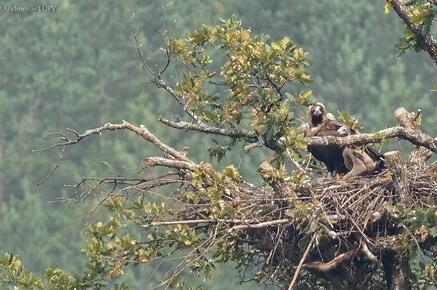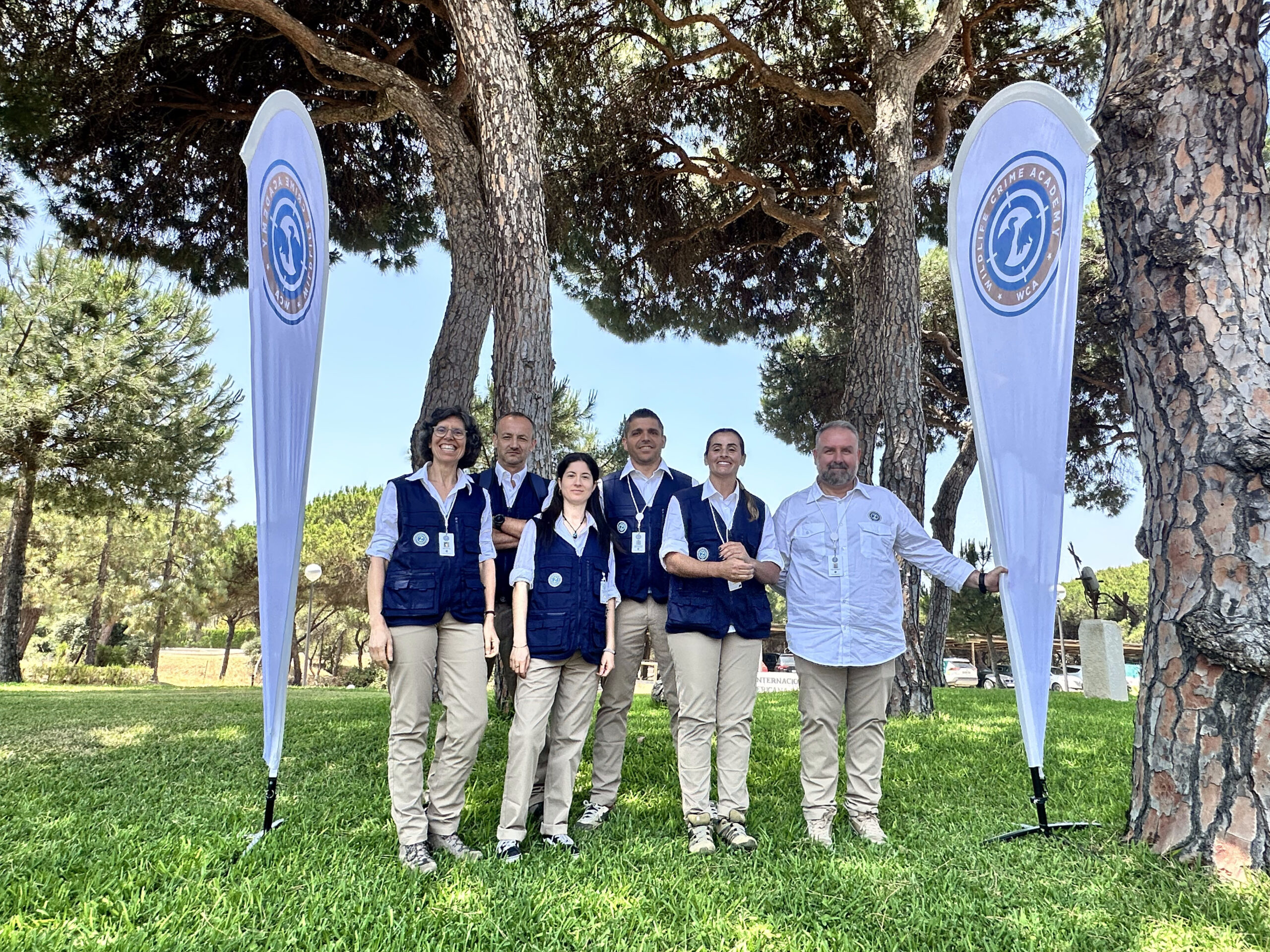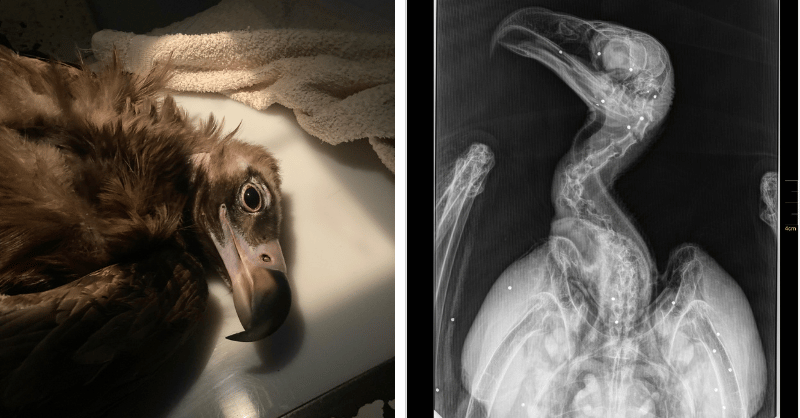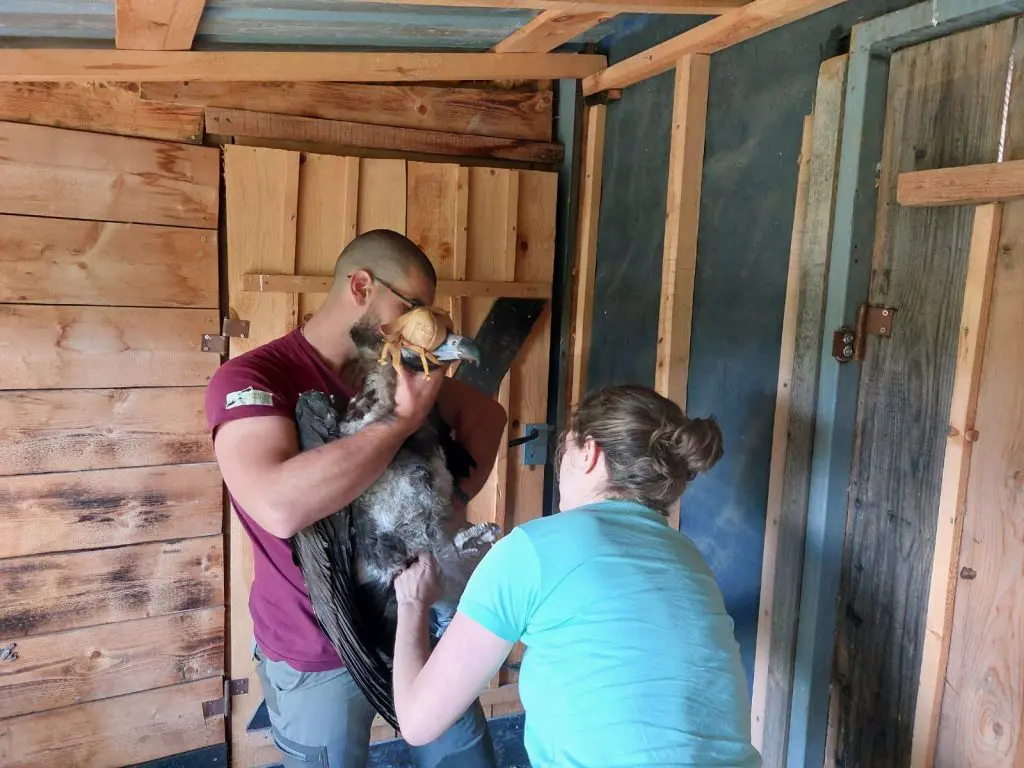GPS/GSM transmitters help reduce mortality, but not all stories have a happy ending.
The tagging of Cinereous Vultures (Aegypius monachus) with a GPS/GSM tag allows tracking the birds’ movements, identifying the causes of any potential mortality, or rescuing them quickly if needed. This summer, two chicks were rescued by the LIFE Aegypius Return project teams. Here are their stories.
Medronho, the chick that flew too soon
At Herdade da Contenda, in Southern Portugal, during this breeding season, three Cinereous Vulture chicks were tagged and later named Medronho, Touril, and Arroio. The chicks are tagged approximately 80 to 90 days after hatching, ensuring they are strong enough to receive the transmitter but not yet eager to jump from the nest due to the tagging team’s approach. If all goes well, Cinereous Vulture chicks begin to make their first flights and leave the nest around 110 to 120 days of age. Thus, after the tagging operations, field surveillance is complemented by continuous monitoring of the information transmitted by the GPS/GSM tags, as this phase is highly sensitive and crucial for determining the survival of each individual.


Medronho, the Cinereous Vulture chick, during the tagging operations on 08/07/2024 at Herdade da Contenda, Portugal. ©Eduardo Santos/LPN
On 21 July, the transmitter of the chick Medronho – a male, then about 95 days old – recorded movements about 50 meters from the nest, which immediately caught the attention of Eduardo Santos, a technician at Liga para a Protecção da Natureza (LPN). A more detailed analysis of the data showed that the chick had thrown itself to the ground or fallen from the nest late in the morning. The fall could have caused injuries and/or left it vulnerable to predators due to its young age and inability to defend itself. Therefore, an LPN rescue team, including two veterinarians, was promptly organized. Upon arrival, the chick was observed and showed difficulty keeping its neck in a normal position, requiring imaging exams. It was hydrated and given the necessary care to ensure its well-being before being transported to the Lisbon Wildlife Recovery Centre (LxCRAS). At LxCRAS, X-rays revealed no evidence of fractures, dislocations, or any other major problems, so it received anti-inflammatory treatment, food, and hydration. On 26 July, the chick was discharged and transported back to the nest, hoping for a “re-adoption” by its parents. Some food was also left in the nest at that time.


Left: Map of Medronho’s movements after falling from the nest (the nest corresponds to the cluster of movements on the far right). Right: Veterinary assessment during the rescue of the chick that fell from the nest ©LPN.

Medronho, the Cinereous Vulture chick, after being placed back in the nest. Some food is also visible in the image. ©Eduardo Santos/LPN.
Seven days of scorching sun
Experience with similar cases shows that, at such a vulnerable age, re-adoption by the parents of a chick placed back in the nest is crucial for its survival. The parents feed and hydrate the chick and protect it from prolonged sun exposure by shading it with their bodies. Young Medronho was returned to a nest fully exposed to the sun when Alentejo was experiencing daytime temperatures above 40⁰C, which could cause the bird to jump from the nest again. The fragility of the situation required constant surveillance. Permanent surveillance shifts were organized from 6:30 AM to 9:00 PM, involving teams from LPN, Herdade da Contenda E.M., and the Institute for Nature Conservation and Forests (ICNF), who stoically monitored the chick, its behaviours, and all movements around it under the scorching Alentejo sun. On the third day of surveillance, with no signs of the parents, it was necessary to replenish food in the nest, requiring another climb of the pine tree where the nest was built. On the fifth day of surveillance (the day the chick Touril began to fly), a Cinereous Vulture approached Medronho and interacted with him, showing some behaviour compatible with that of a parent. However, it was only on the seventh day (August 2nd) that re-adoption was confirmed, with an adult interacting actively with the chick and finally feeding it. Medronho was successfully re-adopted and continued to develop under parental care, finally starting to fly on 22 August, just over 120 days old, precisely one month after its rescue.
Cinereous Vulture chick re-adopted and being fed by a parent. Filmed through a telescope from a great distance to avoid disturbance ©João Santos/ICNF
Rescue at Tejo Internacional
At Tejo Internacional, seven Cinereous Vulture chicks were tagged this year. The transmitter of the young male who received the ring 5E recorded movements outside the nest on August 5th, when the bird should have been only about 107 days old. Fearing a fall from the nest similar to that of Medronho, Paulo Monteiro, a technician from the Portuguese Society for the Study of Birds (SPEA), went to the site and confirmed from a distance that the chick was not in the nest but did not spot it on the ground. He immediately headed to the nest area, and with a careful approach, managed to see the chick in the shade between holm oaks. With the help of ICNF Rangers – and in accordance with the Cinereous Vulture Rescue, Handling, and Transport Protocol – the bird was collected and transported to the Wildlife Studies and Recovery Centre (CERAS), managed by Quercus in Castelo Branco. There, the chick was observed, fed, hydrated, and kept under observation until the next day. With no evidence of trauma or injury, the bird was discharged and returned to the nest the following day, with surveillance immediately beginning from 12:30 PM to 9:00 PM. On 7 August, Paulo Monteiro resumed surveillance at 6:10 AM, but it was brief, as the bird was re-adopted on the same day around 10:00 AM, being fed by one of the parents who remained in the nest for almost an hour.
A few days later, the GPS/GSM transmitter was again crucial in providing important information, although this time it was not encouraging. During daily monitoring, it was found that around 1:00 AM on 11 August, the bird stopped moving. Subsequent observation of the nest from a distance revealed that the bird had fallen from the nest and was apparently dead on the ground. A visit to the nest confirmed the suspicions, and the body was recovered and sent to CERAS for analysis. The necropsy revealed that death was due to internal bleeding caused by trauma, most likely due to this second fall from the nest. Samples were collected and are awaiting toxicological and histopathological evaluation to rule out other causes of death.


Left: Cinereous Vulture chick (5E) recovering at CERAS. Right: Cinereous Vulture chick (5E) in the nest, re-adopted by a parent. Photographed through a telescope from a great distance to avoid disturbance ©Paulo Monteiro/SPEA
Conservation with people and technology
The use of technology such as GPS/GSM transmitters is currently a powerful ally in nature conservation, providing crucial information and allowing the identification and mitigation of threat factors, as well as mortality events. In conservation projects, especially those involving species at high risk of extinction like the Cinereous Vulture, the death of each individual has a significant impact on population recovery. However, it also provides more knowledge about the threats the species face and better prepares us for similar situations in the future. The stories of Medronho and 5E also show us that conservation in the field is only possible thanks to the enormous dedication and commitment of conservationists, veterinarians, and other technicians, enhanced by close collaboration between multiple entities.
We extend a huge thank you and recognition to all the people and institutions involved.
Advisors: Carlos Pacheco, Javier de la Puente, José Pedro Tavares
Entities and people involved:
LPN – Eduardo Santos, David Delgado Rodríguez, Patrícia Couto (voluntária)
LxCRAS – Verónica Bogalho, Érica Brazio e Filipa Lopes
Herdade da Contenda – Pedro Rocha
ICNF – João Santos, João Pepe, André Trindade, Agostinho Tomás, Ângelo Nunes, António Marques e Dinis Monteiro
SPEA – Paulo Monteiro
CERAS/Quercus – Mariana Ribeiro, Inês Pereira, Beatriz Calado, Samuel Infante, Bruna Chaves, Inês Gonçalves, Sofia Ferraz e Gonçalo Gil.
About the LIFE Aegypious Return project

The LIFE Aegypius Return project aims to consolidate the return of the Cinereous Vulture to Portugal and western Spain. It is co-funded by the European Union’s LIFE programme. Its success depends on the involvement of all the relevant stakeholders, and the collaboration of the partners, the Vulture Conservation Foundation (VCF), the coordinating beneficiary, and the local partners Palombar – Conservação da Natureza e do Património Rural, Herdade da Contenda, Sociedade Portuguesa para o Estudo das Aves, Liga para a Protecção da Natureza, Associação Transumância e Natureza, Fundación Naturaleza y Hombre, Guarda Nacional Republicana and Associação Nacional de Proprietários Rurais Gestão Cinegética e Biodiversidade.




